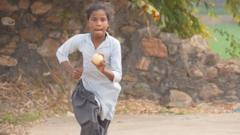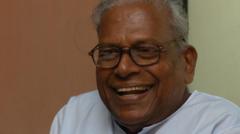Sushila Meena, a cricket-playing girl from a rural village in Rajasthan, unexpectedly gained fame after cricket legend Sachin Tendulkar shared her bowling video. Despite her lack of exposure to the sport, she now faces the pressures of newfound fame against the backdrop of her traditional upbringing.
Rising Star: How a Village Girl Became an Online Cricket Sensation Through Sachin Tendulkar’s Touch

Rising Star: How a Village Girl Became an Online Cricket Sensation Through Sachin Tendulkar’s Touch
Sushila Meena, a 10-year-old from Rajasthan, captures hearts online after Sachin Tendulkar's praise, but her journey is not without challenges.
In a small village in northern Rajasthan, 10-year-old Sushila Meena lived a life defined by simplicity until a video of her bowling was shared by cricketing legend Sachin Tendulkar on social media. The post went viral, capturing the attention of millions, with Tendulkar drawling parallels between her style and that of renowned former bowler Zaheer Khan.
Despite her sudden fame, Sushila remains blissfully unaware of Tendulkar’s stature in the cricketing world, having never watched a match or owned a television. "I don’t know who he [Sachin Tendulkar] is," she says, reflecting on her life before the newfound recognition. However, the overwhelming support from friends, family, and even politicians has transformed her existence; she now encounters enthusiastic fans wherever she goes.
On the cricket field, Sushila’s transformation is striking. She sheds her shyness and channels an ambition and focus that belies her age. Her classmates, particularly a friend named Asha, commend her agility and skill, noting, "Her ball turns unexpectedly and suddenly hits the wicket."
Sushila's mother, Shantibai, beams with pride about her daughter’s achievements, though she faces mixed reactions within her community. While many are supportive, some criticize Shantibai for allowing Sushila to pursue cricket, viewing it as improper for girls in their traditional society. Shantibai remains resilient, asserting, "I will never stop her from playing cricket."
Cricket has become a focal point at Sushila’s school, thanks to the encouragement from her teacher, Ishwarlal Meena. He passionately believes in using the sport to engage students academically and has even formed teams to keep kids interested. Lacking formal training, Mr. Meena learns techniques through online videos to coach his students. They have also created a social media account to showcase their talent, attracting attention and advice from the public.
While Sushila is now part of an exciting narrative, the reality remains grim for her village and school, which continue to grapple with inadequate facilities and opportunities. Mr. Meena expresses frustration, stating, "People come, they make big promises, but nothing changes." The local government's proposed solutions remain unfulfilled, with no signs of improvement for the limited educational resources available to students beyond primary grades.
Sushila's home has become a hub of attention, with gifts pouring in, including numerous cricket bats. However, practical needs like proper cricket balls for higher-level play are yet to be addressed. As she shyly contemplates how to manage her gifted bats, the question lingers: will this viral fame translate into genuine change or simply fade like the gifts?
Sushila’s story serves as a compelling reminder of the challenges faced by budding talent in rural India, raising hopes for a brighter future while highlighting pressing societal issues.





















